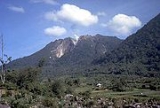
Sibayak
Encyclopedia
Mt. Sibayak is a small stratovolcano
overlooking the town of Berastagi
in northern Sumatra
, Indonesia
. Although its last eruption was more than a century ago, geothermal activity in the form of steam vents
and hot spring
s remains high on and around the volcano. The vents produce crystalline sulfur
, which was mined on a small scale in the past. Seepage of sulfurous gases has also caused acidic discolouration of the small crater lake
.
Sibayak is a term from the Karo
Batak
language referring to a founding community. It is relatively easy to climb and has been a tourist attraction
since colonial times.
Stratovolcano
A stratovolcano, also known as a composite volcano, is a tall, conical volcano built up by many layers of hardened lava, tephra, pumice, and volcanic ash. Unlike shield volcanoes, stratovolcanoes are characterized by a steep profile and periodic, explosive eruptions...
overlooking the town of Berastagi
Berastagi
Berastagi is a town and subdistrict of Karo Regency situated on crossroads on the main route linking the Karo highlands of Northern Sumatra to the coastal city of Medan...
in northern Sumatra
North Sumatra
North Sumatra is a province of Indonesia on the Sumatra island. Its capital is Medan. It is the most populous Indonesian province outside of Java. It is slightly larger than Sri Lanka in area.- Geography and population :...
, Indonesia
Indonesia
Indonesia , officially the Republic of Indonesia , is a country in Southeast Asia and Oceania. Indonesia is an archipelago comprising approximately 13,000 islands. It has 33 provinces with over 238 million people, and is the world's fourth most populous country. Indonesia is a republic, with an...
. Although its last eruption was more than a century ago, geothermal activity in the form of steam vents
Fumarole
A fumarole is an opening in a planet's crust, often in the neighborhood of volcanoes, which emits steam and gases such as carbon dioxide, sulfur dioxide, hydrochloric acid, and hydrogen sulfide. The steam is created when superheated water turns to steam as its pressure drops when it emerges from...
and hot spring
Hot spring
A hot spring is a spring that is produced by the emergence of geothermally heated groundwater from the Earth's crust. There are geothermal hot springs in many locations all over the crust of the earth.-Definitions:...
s remains high on and around the volcano. The vents produce crystalline sulfur
Sulfur
Sulfur or sulphur is the chemical element with atomic number 16. In the periodic table it is represented by the symbol S. It is an abundant, multivalent non-metal. Under normal conditions, sulfur atoms form cyclic octatomic molecules with chemical formula S8. Elemental sulfur is a bright yellow...
, which was mined on a small scale in the past. Seepage of sulfurous gases has also caused acidic discolouration of the small crater lake
Crater lake
A crater lake is a lake that forms in a volcanic crater or caldera, such as a maar; less commonly and with lower association to the term a lake may form in an impact crater caused by a meteorite. Sometimes lakes which form inside calderas are called caldera lakes, but often this distinction is not...
.
Sibayak is a term from the Karo
Karo (people)
The Karo, or Karonese, are a Batak people of the 'tanah Karo' of North Sumatra and a small part of neighbouring Aceh. The Karo lands consist of Karo Regency, plus neighbouring areas in East Aceh Regency, Langkat Regency, Dairi Regency, Simalungun Regency and Deli Serdang Regency...
Batak
Batak (Indonesia)
Batak is a collective term used to identify a number of ethnic groups predominantly found in North Sumatra, Indonesia. The term is used to include the Toba, Karo, Pakpak, Simalungun, Angkola and Mandailing, each of which are distinct but related groups with distinct, albeit related, languages and...
language referring to a founding community. It is relatively easy to climb and has been a tourist attraction
Tourist attraction
A tourist attraction is a place of interest where tourists visit, typically for its inherent or exhibited cultural value, historical significance, natural or built beauty, or amusement opportunities....
since colonial times.

